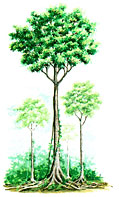|
||||||||||||||||||
|
Honduras Mahogany Excerpted from the book: Wood
: Classic Woodworking Woods : And How to Use Them
Although English shipbuilders marveled at the new seagoing stock, it was the joiners who really appreciated this New World treasure. They could span greater lengths and widths that any other wood available, due to the sheer size of the mahogany timbers. By the late 1700s, the now famous English cabinetmakers Chippendale, Hepplewhite, and Sheraton were shaping mahogany into classic furniture styles that kept the wood prominent for 150 years. Today's woodworker still finds delight in working mahogany into elegant cabinets, desks, tables, and other furniture. Often referred to in the wood trade as Tropical American mahogany, Honduras mahogany (Swietenia macrophylla) grows throughout much of Central and South America, including southern Mexico. However, the first mahogany discovered by Spanish explorers was Cuban mahogany (Swietenia mahogoni), a species no longer commercially available. Philippine mahogany isn't a mahogany at all, but rather a Shorea species called lauan. In the forest, Honduras mahogany sometimes attains 150' heights and diameters of 72". Trees planted and grown for lumber on plantations (found in mahogany's natural range and the South Pacific), run smaller. Honduras mahogany on the stump has a heavily buttressed trunk base, scaly gray bark, and leaves displaying six to eight leaflets arranged on a single stem, much like those of the black walnut tree. Honduras mahogany wood has straight, semi-open grain and a color that ranges from yellow-brown to dark red, depending on where it grows. With age, though, mahogany of all colors becomes a rich, dark red-brown. The wood also may display exceptional fiddleback, quilt, and ribbon-stripe figure. A bit lighter than maple at 32 pounds per cubic foot, Honduras mahogany matches oak in strength. The wood also withstands moisture, resists fire and decay, and remains stable in use. Mahogany claims the qualities that make it the ideal stock for majestic desks, tables and large cabinets. Both turners and carvers find the wood suited for intricately detailed work. And, today's boatbuilders, like those centuries ago, turn to Honduran mahogany for structural members, decking, and trim. Choose any type of stain or finish for your Honduras mahogany project because the wood accepts them all equally. It also takes and holds paint exceptionally well, but you'll need a primer coat and several top coats to completely fill the wood's open grain. Paul McLure, WOOD magazine's
consultant on wood technology, calls Honduran mahogany, "the
wood by which all other woods are measured". By that, he means
you couldn't ask for a better wood to work. And, all the craftsmen
we asked agree with him. So, note our advice, and enjoy this singular
stock. |

Pastoral
Furniture Co. 997 Hauck Rd. Mechanicsburg, PA
17055 717.766.8305
e-mail:
brianober@pastoralfurniture.com
| Welcome | Tables | Chairs | Sundries | Purchase | Contact |
All wood furniture designs© 1999-2011 Pastoral Furniture Co.
